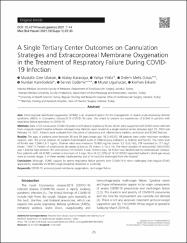| dc.contributor.author | Ulukan, Mustafa Özer | |
| dc.contributor.author | Karakaya, Atalay | |
| dc.contributor.author | Yıldız, Yahya | |
| dc.contributor.author | Öztaş, Didem Melis | |
| dc.contributor.author | Kamilçelebi, Nurdan | |
| dc.contributor.author | Özdemir, Servet | |
| dc.contributor.author | Uğurlucan, Murat | |
| dc.contributor.author | Erkanlı, Korhan | |
| dc.date.accessioned | 2021-08-13T08:27:45Z | |
| dc.date.available | 2021-08-13T08:27:45Z | |
| dc.date.issued | 2021 | en_US |
| dc.identifier.citation | Ulukan, M. Ö., Karakaya, A., Yıldız, Y., Öztaş, D. M., Kamilçelebi, N., Özdemir, S. ... Erkanlı, K. (2021). A single tertiary center outcomes on cannulation strategies and extracorporeal membrane oxygenation in the treatment of respiratory failure during COVID-19 infection. The Medical Bulletin of Haseki, 59, 25-30. https://dx.doi.org/10.4274/haseki.galenos.2021.7144 | en_US |
| dc.identifier.issn | 1302-0072 | |
| dc.identifier.uri | https://dx.doi.org/10.4274/haseki.galenos.2021.7144 | |
| dc.identifier.uri | https://hdl.handle.net/20.500.12511/7813 | |
| dc.description.abstract | Aim: Extracorporeal membrane oxygenation (ECMO) is an important option for the management of severe acute respiratory distress syndrome (ARDS) in Coronavirus disease-2019 (COVID-19) cases. We aimed to present our experiences of ECMO in patients with respiratory failure secondary to COVID-19. Methods: Data of 22 consecutive COVID-19 patients with severe respiratory failure whom were supported with ECMO were collected from computer-based hospital software retrospectively. Patients were treated in a single medical center between April 23, 2020 and February 14, 2021. Patients were analyzed from the points of laboratory and inflammatory markers, ventilation and ECMO features. Results: The ages of patients were between 30 and 69 years (mean age: 56.3±10.63). All patients were under maximum ventilator support, with the prone position. All patients had elevated levels of inflammatory indicators as D-dimer and ferritin. The mean level of ferritin was 1, 564±1, 611 ng/mL. D-dimer value was maximum 10.000 mg/mL (mean: 5, 215±3, 104), CRP increased to 177 mg/L (mean: 159±71). Percent of lymphocytes decreased as low as 2% (mean: 4.16±2.10). The mean duration of veno-arterial (VA) ECMO was 1.6±0.94 days whereas, for veno-venous (VV) ECMO, it was 10.05±5 days. VA ECMO was decided due to cardiovascular collapse. Four patients with VA ECMO survived a maximum of 3 days. Four of (22.22%) of 18 VV ECMO supported patient’s blood gas values were at normal ranges, 3 of them needed tracheostomy, and all of could be discharged from the hospital. Conclusion: Although, ECMO support for severe respiratory failure patients with COVID-19 is more challenging than regular ECMO applications, especially VV ECMO usage should be reminded as a remedy. | en_US |
| dc.language.iso | eng | en_US |
| dc.publisher | Galenos | en_US |
| dc.rights | info:eu-repo/semantics/openAccess | en_US |
| dc.subject | COVID-19 | en_US |
| dc.subject | Extracorporeal Membrane Oxygenation | en_US |
| dc.subject | Multi-Organ Failure | en_US |
| dc.title | A single tertiary center outcomes on cannulation strategies and extracorporeal membrane oxygenation in the treatment of respiratory failure during COVID-19 infection | en_US |
| dc.type | article | en_US |
| dc.relation.ispartof | The Medical Bulletin of Haseki | en_US |
| dc.department | İstanbul Medipol Üniversitesi, Tıp Fakültesi, Cerrahi Tıp Bilimleri Bölümü, Anesteziyoloji ve Reanimasyon Ana Bilim Dalı | en_US |
| dc.department | İstanbul Medipol Üniversitesi, Tıp Fakültesi, Cerrahi Tıp Bilimleri Bölümü, Kalp ve Damar Cerrahisi Ana Bilim Dalı | en_US |
| dc.authorid | 0000-0001-9919-8392 | en_US |
| dc.authorid | 0000-0002-2901-4807 | en_US |
| dc.authorid | 0000-0001-5485-5440 | en_US |
| dc.authorid | 0000-0003-4741-7877 | en_US |
| dc.authorid | 0000-0001-6643-9364 | en_US |
| dc.authorid | 0000-0001-6182-5055 | en_US |
| dc.identifier.volume | 59 | en_US |
| dc.identifier.startpage | 25 | en_US |
| dc.identifier.endpage | 30 | en_US |
| dc.relation.publicationcategory | Makale - Uluslararası Hakemli Dergi - Kurum Öğretim Elemanı | en_US |
| dc.identifier.doi | 10.4274/haseki.galenos.2021.7144 | en_US |
| dc.identifier.scopusquality | Q4 | en_US |


















